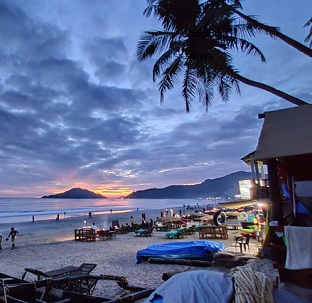Information about Goa
Information about Goa, Goa, popularly known as the pearl of the east, is famous for its churches, ancient ruins, and beaches with palm trees, coconut trees, ferry rides and popular music. With its 131 km of coastline, Goa is an important destination in the itinerary of all tourists. Goa is one of the special places in India, a state seemingly blessed with a fabulous climate, even more fabulous beaches, charming people, good food, forts at the top of the hills, small white churches, cathedrals of the Portuguese era, a unique cultural legacy-little wonder, therefore, that Goa is one of India’s top holiday destinations. Sun, sand and sea are the main attractions, Goa is a perfect paradise for those who need and want relaxation. The beaches in Goa on the coast of Kankan are long, and straight with palm trees unlike the neighboring coast.
Goa has beautiful houses, landscape, infrastructure, hotels, beach, bars and resorts. There are 5-star luxury hotels, for hippie shops, amazing markets and street vendors. Goa is full of yuppies hoping to shut down and relax for a few days, and sun-hungry Europeans, soaking up all that glorious sun and food. This state is on the western coast of India. Goa is close to Maharashtra and share the TEREKHOL River in the north and the Arabian Sea in the west. Goa, as a region, which divides into four divisions – the Eastern Hill region, which comprises areas in the Western Ghats, such as SATTARI, PONDA and SANGUEM, the Central Valley Lands, comprising EASTERN SANGUEM, and QUEPEM; the alluvial plains, comprising the coastal plains and rolling plateaus; and the coastal plains with the areas of TISWADI, MORMUGAO, BARDEZ, and SALCETE.



Facts about Goa (Information about Goa).
Temperatures in Goa are moderate with little variation. Summer is at its warmest in May, while the winter months of January and February are the coldest. Most of the time Goa experiences tropical weather all of the year. However, Goa receives rains from the southwest monsoons between June and September. There is significant rainfall in July while February is the driest month. In addition, agriculture is one of the most important economic activities in Goa. Goa has done a lot to improve and develop its agriculture to make it more productive and farmers working in the field get a better return to their work. Rice along with fish is the basic diet of people and is also a major agricultural crop.
The main crops in Goa are rice fields, RAGI, CORN, JOWAR, BAJRA AND legumes. Cash crops such as coconut, cashew, clam, mango, jackfruit, banana, pineapple, etc. are also grown in abundance. Moreover, sugar cane cultivation was recently resumes and a sugar factory activates in Goa. Paddy is Goa’s main crop. Monsoon cultures are called KHARIF or SOROD cultures and winter cultures are Rabi or VAINGAN cultures. The main sources of irrigation for winter crops are NALLAHS, rivers and streams, ponds, wells, canals, etc. Crops grown in the KHARIF station consist of rice paddies and some pulses.
